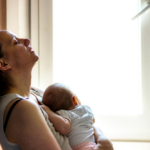Ask the Experts: Safe sleep practices for infants
This month’s Ask the Experts topic is sleep. This week, […]
This month’s Ask the Experts topic is sleep. This week, Anne H. Zachry, Ph.D., mother of three, pediatric occupational therapist and member of the American Occupational Therapy Association shares safe sleeping tips to practice with your infant.

Another danger to infants is accidental suffocation during sleep. This can occur when an infant sleeps with soft bedding, pillows, on a waterbed mattress, or when a parent rolls on top of or against baby during sleep. There is also a risk of an infant becoming wedged between two objects such as a fluffy bumper pad and a bed frame.
Parents are responsible for choosing where and how their baby sleeps at night and naptime, and there are a number of precautions that can be taken to keep baby healthy and safe. Every parent and caregiver should be familiar with the following AAP recommendations regarding safe sleep practices for infants:
- Adhere to the AAP “Back to Sleep” recommendation: Infants should be placed on their backs for sleep. Side sleeping is not advised because babies can roll from the side to the stomach while sleeping.
- Use a firm sleep surface: Use a safety-approved crib with a firm mattress covered by a tightly fitting sheet. Avoid using soft fabrics, blankets, pillows, quilts, comforters, or sheepskins in the crib.
- Keep soft objects and loose bedding out of the crib: If a bumper pad is used, it should be thin, firm, & well secured.
- Avoid blankets, which can cover baby’s head, rather use sleep clothing with no other covering over the infant.
- A separate but proximate sleeping environment is recommended: The risk of SIDS is reduced when baby sleeps in the same room as the mother in a separate crib. Place the baby’s crib or bassinet near your bed (within an arm’s reach).
- Do not smoke during pregnancy or around baby: Second hand smoke increases baby’s risk of SIDS.
- Don’t let baby overheat: Your infant should be lightly clothed for sleep, and the bedroom temperature should remain comfortable.
- Consider offering a pacifier at nap time and bedtime: There is a reduced risk of SIDS associated with pacifier use during sleep.
- Stick with a crib or bassinet: Never let your infant sleep on a couch, armchair, cushion, or an adult bed (there are no safety standards for mattresses other than crib mattresses).
- Avoid commercial devices marketed to reduce the risk of SIDS: Don’t use sleep positioners. They pose a risk for suffocation as baby can become trapped and suffocate between the sleep positioner and the side of a crib or bassinet.
- No bed sharing: Evidence is growing that bed sharing is more hazardous than when the infant sleeps on a separate sleep surface; therefore, the AAP recommends that infants not bed share with parents or siblings during sleep.
- Do not rely on home monitors as a strategy to reduce the risk of SIDS: There is no evidence that home monitors decrease the incidence of SIDS.
- Limit carrier time: If your baby falls asleep in a carrier, remove and place him in a bassinet or crib as soon as possible. The hard plastic surface of a carrier is not meant for extended use, and sleeping for extended periods in these devices can cause a flat spot to form on your infant’s head.
Review these safe sleep practices with everyone who cares for your baby: This includes childcare staff, babysitters, grandparents, and friends. Don’t take any chances! Every individual who cares for your infant should be aware of safe sleep practices.
Don’t forget tummy time: Now that infants are sleeping on their backs, it is especially important to expose them to tummy time on a daily basis to improve head control and upper body strength, which are necessary for the developmental milestones of rolling over, pulling up, and crawling. Exposing babies to tummy time also reduces the risk of flat spots forming on the head.







